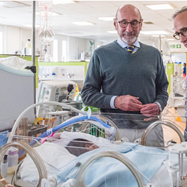Meeting the 2.4% target
27 November 2018
Senior Policy Analyst Stephanie Smith on why the Government needs a plan if it is to meet its target of investing 2.4% of GDP in research and development by 2027.
Last week the House of Commons Science & Technology Committee held an important session on research and innovation spending.
What did we learn about the Government’s commitment to invest 2.4% of GDP on R&D by 2027, with a longer-term commitment to hit 3%?
First, the target is ambitious when compared with today’s spending (1.7%), but less bold when set in an international context. The US is already at 2.7%, Germany at 2.9%, while South Korea and Israel are over 4%. Our target was chosen because it’s the average amount OECD countries invested in R&D in 2015. But as Nesta’s Kirsten Bound pointed out, we shouldn’t aspire to be average. Even if we reach our target in the timeframe that has been set, against our competitors we’ll still be running to stand still.
Second, to leverage the private investment needed, the Government must commit significant additional funds. Two-thirds of R&D investment in the UK comes from the private sector. The Treasury will, therefore, need to cover at least one-third of the expected uplift. As Sarah Main, Executive Director of the Campaign for Science and Engineering (CaSE), pointed out this translates to around an additional £9 billion a year in public spending by 2027 (more information on CaSE’s figures can be found here). Next year’s Comprehensive Spending Review will reveal whether Ministers will deliver.
Third, UK universities have a huge role to play. It might be typically British not to dwell on our strengths, but the message to the committee from European researchers was that the UK’s higher education sector is a clear national asset. With less than 1% of the world’s population and just 4% of the world’s researchers, the UK earns 12% of international citations and 16% of the most cited papers.
The REF has been instrumental to this performance, allowing us to punch well above our weight internationally and it’s likely the HE sector will need to be much more vocal about this in the months ahead if QR – which is competitively won through the REF – is to be supported going forward. The European witnesses were clear: from skills provision to research, commercialisation to innovation ecosystem building, UK universities are being asked to do it all, and as James Wilsdon of the University of Sheffield pointed out, much of this work is underpinned by QR.
As with many Select Committee hearings, however, important points were left unsaid. No one mentioned that the UK previously had a similar R&D investment target which was spectacularly missed. In 2004, the then Labour Government committed to investing 2.5% of GDP by 2014. Over the ten years, R&D investment grew from 1.4% to just 1.6%. Lessons must be learnt if we are to avoid repeating past mistakes.
Pulling together
One such lesson may be around coordination. Strategies are only as good as their implementation. The Department for Business, Energy and Industrial Strategy and UK Research and Innovation are behind the 2.4% target, but together they represent around 70% of government spending on R&D. How do we ensure the National Health Service and Ministry of Defence, for example, two departments responsible for considerable R&D spending, are also on board?
Indeed, many aspects of the 2.4% commitment are out of UKRI and BEIS’s control. Several reports, including from the Royal Academy of Engineering, have found the most important factors affecting business investment in R&D are the quality of local infrastructure (roads and rail) and cross-departmental government coherence.
Immigration policy is high on this list too, as foreign business investors need access to high-quality talent, no matter where it is from. To this end, what power do BEIS and others have over the Home Office? And how is local government being involved, given local councils can sometimes hamper foreign direct investment through restrictive approaches to planning permission?
Success is going to require coordination. The government cannot do things the way it always has and expect different results. A more joined-up approach will be needed, with responsibility for achieving 2.4% shared across departments and co-ordinated at the highest levels.
Jigsaw or Jenga?
Also noticeable by its omission was the post-18 education and funding review. At the Committee hearing, no one referred to reports that Philip Augar’s panel may advise the government to cut tuition fees, even though the impact on the UK’s research base could be significant. If the income lost by such a fee cut was not replaced in full by teaching grants, higher education budgets could face a significant shortfall. We already know research council grants fund around 70% of the real cost of research. Universities cover the rest through other income streams, including international student fees. If institutions are expected to use overseas fees to support domestic teaching, research could pay a heavy price.
So where next on 2.4%? BEIS is expected to produce its promised roadmap any day now. Hopefully, this will reflect the many moving pieces in this jigsaw – with OfS and DfE moving in one direction on teaching funding, and BEIS and UKRI potentially moving in another on research, some kind of oversight is desperately needed.
Indeed, with the loss of HEFCE, there is a very real risk that no one is looking at whether universities will be sufficiently sustainable to deliver on research, teaching, knowledge exchange, the industrial strategy and wider civic responsibilities – all at once.
Originally published by WonkHE.
 X
X

